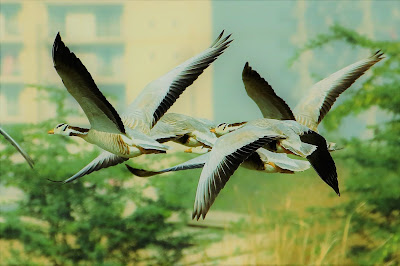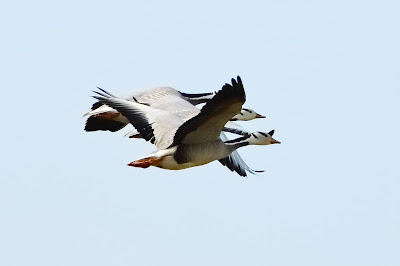 |
| Bar-headed Geese at the Basai Wetland, Gurgaon |
Each year that passes sees fewer and fewer migratory birds visiting the Sultanpur National Park in Gurgaon. One can see a definite shift in the preference that most migratory birds have for other sites rather than the National Park. The Basai Wetland despite the construction work taking place nearby in terms of a new flyover and the Dwarka expressway continues to be a favourite with Bar-headed Geese, Northern Pintail, Spot-billed Ducks and even greater Flamingos. It goes without saying that I have spotted more species of birds per visit to the Basai Wetland than at the Sultanpur National Park.
 |
| Bar-headed Geese on grass-covered flats of the Basai Wetland |
Another more preferred site for migratory birds during the winter months happens to be the Najafgarh wetland or lake. Though I have not personally visited the Najafgarh lake in Delhi, I have, nevertheless, read numerous reports in the English dailies about the presence of a large number of migratory birds at the wetland. While one might wonder why migratory birds seem to prefer other sites rather than the Sultanpur National Park, evidence suggests that this might be the result of Geographical factors. Perhaps, one of the most important factors could be the developmental activities taking place in the area. The development taking place around the National Park has cut off the natural rainwater channels that feed the ponds in the National Park. This lack of freshwater is fast changing the National Park into a scrubland. An attempt has been made to get some water from a river nearby but then even this is not a good substitute for the water collected during the rains.
 |
| Bar-headed Geese take off only to circle back and land. |
This year, it looks like the Basai Wetland is the favoured breeding ground for Bar-headed Geese, that too in spite of the Construction and Demolition waste treatment plant close by and the flyover coming up nearby. Such a large number of Bar-headed Geese has never before been spotted at the Basai wetland that too for so many months. In the past, Bar-headed Geese would stop at the Basai Wetland for a few days and not months. The birds that I had spotted in the month of December 2020 were very much there when I visited the wetland today. It looks as if these migratory birds have made the Basai wetland their winter home.
 |
| A pair of Bar-headed Geese at the Basai Wetland |
So does this mean that the Bar-headed Geese have made a conscious decision to make the Basai Wetland their winter home? Could it be that the Geographical factors have resulted in a change of choice of breeding grounds for migratory birds that visit the city of Gurgaon? The lack of freshwater resources and suitable feeding grounds might have forced most migratory birds to give the Sultanpur National Park a miss. One very important factor affecting the migratory patterns of Bar-headed Geese is the availability of food. In the case of Bar-headed Geese, the availability of cereals, rice, wheat grains and other seeds form an important part of their diet. Wetlands are complex ecosystems that support a sizeable population of flora and fauna. Lack of fresh water, grass, seeds, insects and fish forces migratory birds to seek alternative sites to sustain them through the winter months which also happen to be their breeding season in the Northern plains of India. Simply diverting water from a nearby river in order to fill depressions with water might not provide sustenance to most of the migratory birds that visit the area.
 |
| Bar-headed Geese feeding on seeds buried in the grass. |
Reclamation of wetlands for agricultural, industrial and residential purposes and the blocking up of rainwater channels that feed the wetlands are some of the known factors affecting the migratory patterns of Bar-headed Geese. The need of the day is for scientists and conservationists to study factors affecting the migratory patterns of these birds. Unless more is done to protect and rejuvenate the wetlands in and around Gurgaon, we will see fewer and fewer of these rather magnificent birds. Incidentally, these are the only birds in the world that can fly at a height of 20,000 feet, and most of them fly in from as far away as Mongolia and Tibet! Researchers believe that the number of Bar-headed Geese that visit the plains of India is already on the decline. It is a matter of concern that nothing much is being done to preserve the winter habitats of these amazing birds!
 |
| Bar-headed Geese at play on the green patches of the Basai Wetland |
Looking at the Bar-headed Geese at play one can't help wonder if they might not deserve a better deal in terms of the protection of their natural winter breeding habitats. These birds have been flying in for ages every winter and they certainly have the right to return to their natural breeding grounds.
 |
| One of a pair of Geese stands guard while the other feeds. |
It is very clear that Breeding Bar-headed Geese like to feed on seeds, grains and cereals on the ground. They enjoy settling on grass-covered land and not necessarily paddle on the water all the time. Most of the times they can be seen feeding on bits of seeds on the ground. Though they have webbed feet and happen to be good swimmers, they can be seen happily moving around on grass-covered land. Perhaps one of the reasons why they prefer to settle at the Basai wetland in Gurgaon is because of the abundant expanses of grass-covered land. The receding waters leave behind a rich carpet of green grass that provides the birds with enough food to forage on. Most of the National Parks, unfortunately, do not have enough grass-covered land to allow these birds to forage on. That incidentally is what makes all the difference to Bar-headed Geese. The lack of fertile land, land that supports thick vegetation, even grass is of major importance. When you fill-up the shallows in a National Park with water but don't do anything to make the soil fertile so that it can sustain insects, seeds from grass, and create a sort of trap for wind-blown seeds, you are really not creating a viable environment for migratory birds to survive on! A lot many of our National parks are mere scrublands as such, they don't really support migratory birds like the Bar-headed Geese.













